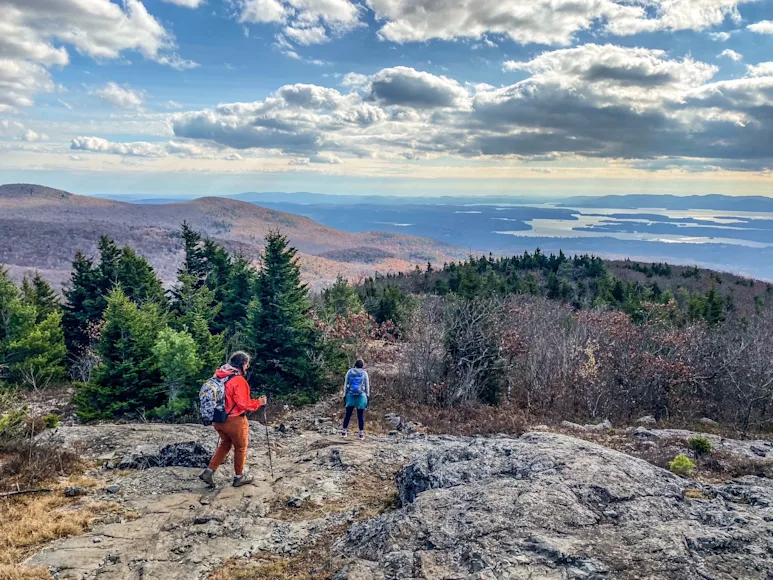_We may earn revenue from the products available on this page and participate in affiliate programs. Learn more ›
_
Best for Women
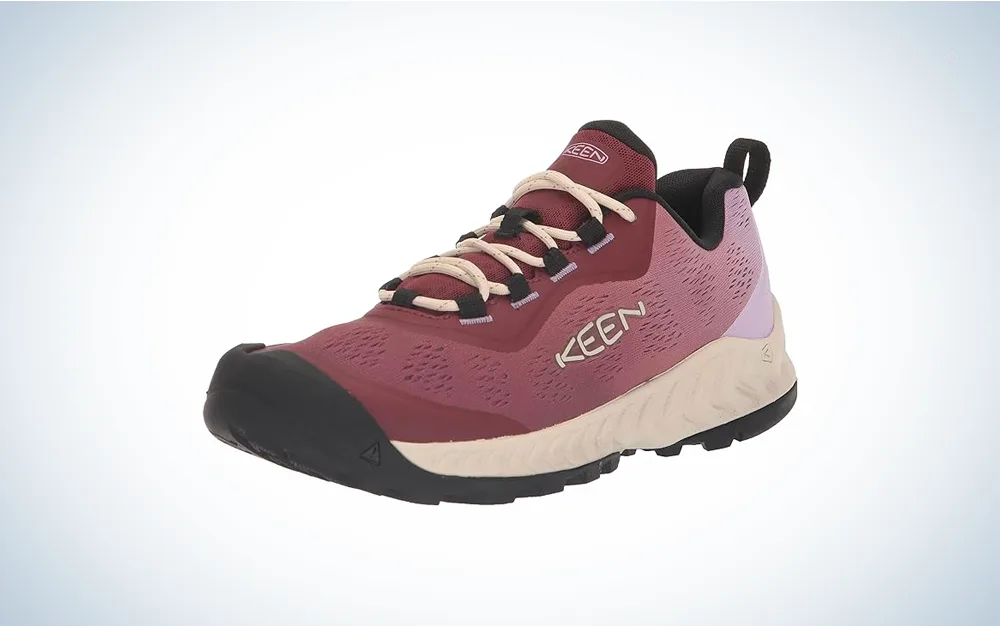
Keen NXIS Speed
Best Men

La Sportiva Ultra Raptor II
Best Waterproof
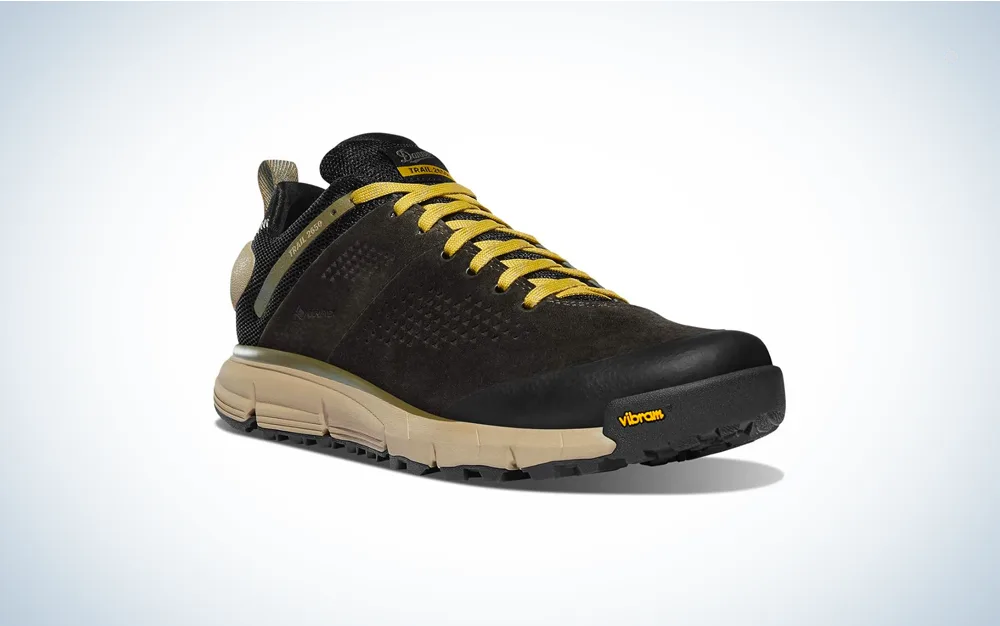
Danner Trail 2650 GTX
Whatever your outdoor adventures entail, finding the right hiking shoes can mean the difference between a comfortable foot and a blistered experience. Unlike a traditional hiking boot, hiking shoes feature a low-top design to keep your foot protected and comfortable over roots and rocks. However, just like all trails aren’t the same, hiking shoes vary as well.
While some cater to trail runners looking for lightweight hiking shoes
that can handle dirt roads and packed trails, others are designed to handle rugged rock peaks and a range of temperatures and moisture. We’ve done the work to test and compile a list so you can find a pair that will ensure comfort and confidence on the trail. Here are the best hiking shoes for a variety of pursuits.
Best for Women: Keen NXIS Speed
Best for Men: La Sportiva Ultra Raptor II
Best Waterproof: Danner Trail 2650 GTX
Best for Thru Hiking: Topo Traverse
Best Lightweight: Vasque Re: Connect Here Low
Best for Beginners: Oboz Sawtooth X Low
Most Comfortable: Hoka Anacapa Low GTX
How We Picked the Best Hiking Shoes
As a New Hampshire based adventurer, my hiking shoes are exposed to everything from the steep and rocky trails of the White Mountain wilderness to the wooded rolling hills of our Lakes region to the muddy marshes on the coast. In order to choose the best hiking shoes, I pulled from my experience as a recreational hiker as well as a wilderness guide. These shoes were put to the test on a range of trails and terrain following the following methodology:
Brand Research and Shoe Selection: Through careful research, I selected a range of popular models from reputable brands. My goal was to choose a diverse selection that covered variety in fit, support, traction, and climate.
Field Testing: Each pair of shoes went through rigorous testing in the fall months in New England. Weather ranged from hot, summer-like days to late-fall brisk hiking. I selected an experienced male tester to aid me with the men’s category.
Evaluation: Our tested hiking shoes were evaluated on fit, comfort, versatility, and traction. Special attention was given to how well the outsole handled a variety of different surfaces, including a packed trail, mud, rock, slab, and gravel.
User Reviews and Experiences: In order to make the final cut, I also talked with and interviewed peers with similar hiking expertise to get a broader range of feedback.
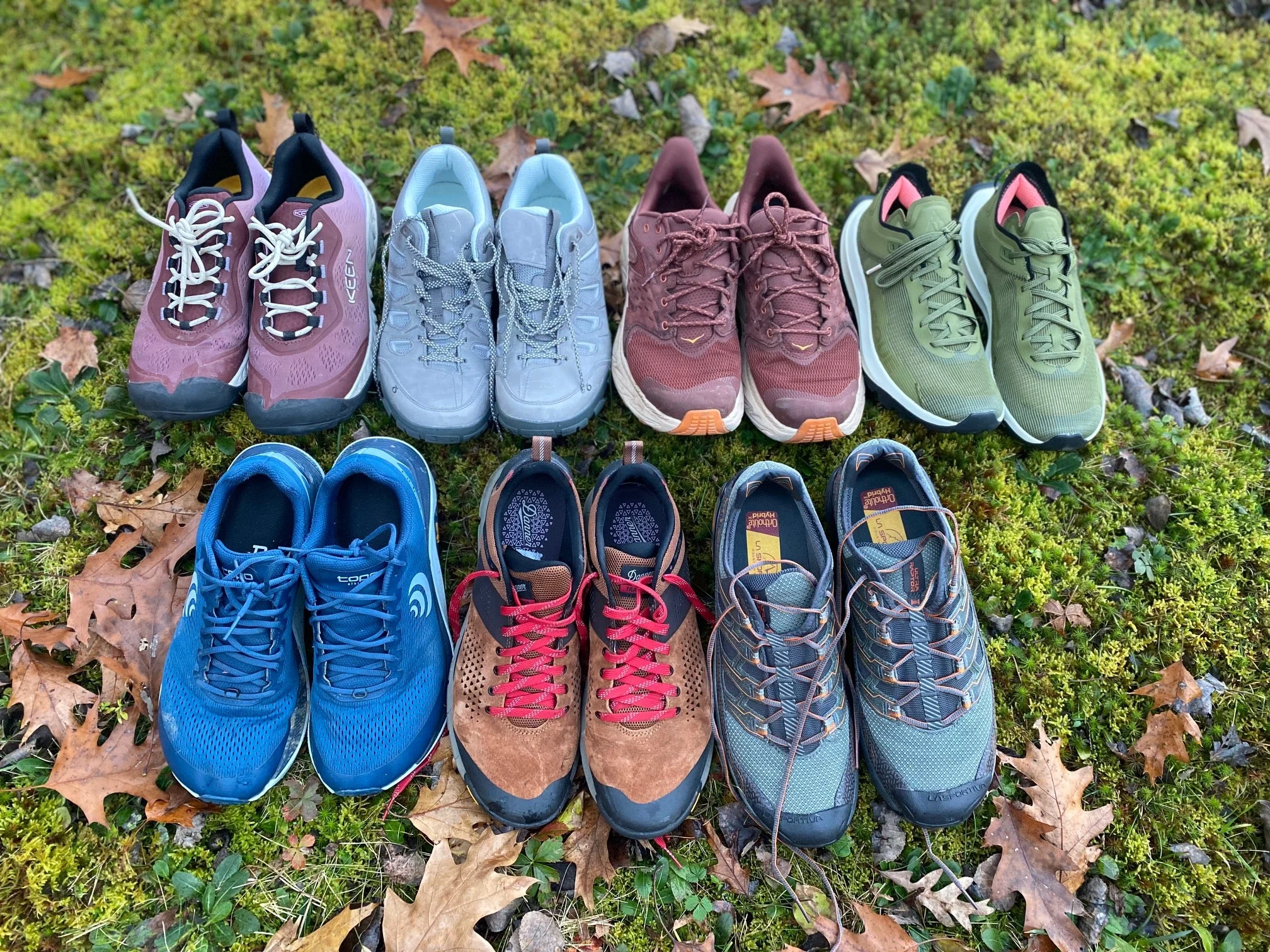
The testing lineup for our hiking shoes shootout. Lindsey Lapointe
Best Hiking Shoes: Reviews and Recommendations
Best for Women: Keen NXIS Speed

Specs
Weight Per Pair: 1.3 pounds
Traction: Keen’s all-terrain outsole with 4 mm multi-directional lugs
Waterproof: Water-repellent mesh (not waterproof)
Pros
Excellent ventilation
Protective toe cap
Comfortable
Cons
Not Waterproof
I’ve been a fan of the Keen hiking boots for a long time. In fact, I exclusively wore Keen Targhee boots for five years due to their comfortable fit. The early adoption of a wide toe box as well as a protective toe cap fostered a dedicated following among rugged terrain hikers. I was skeptical that the Keen NXIS Speed would meet the mark of its predecessors, but it surpassed previous models in almost every category.
The NXIS speed is advertised as a lightweight hiking sneaker, and at 10 ounces a shoe, it feels lightweight, yet supportive. The mesh sides are breathable but durable, and the color choices are fun and flattering. I was happy to see that Keen kept a wide toe box and an extra protective toe cap. When I tested the shoes in the rough terrain of New Hampshire, the toe cap saved me more than once from injury. Keen’s all-terrain tread fared just as well on muddy trails as it did on granite slabs. Overall, this is a great three-season hiking shoe for a variety of terrain. From its comfy fit right out of the box to its rugged outsole, this lightweight hiking shoe is a perfect hiking footwear for most women.
Best for Men: La Sportiva Ultra Raptor II

Specs
Weight Per Pair: 1.5 pounds
Traction: FriXion rubber and Trail Bite heel with 4.5 mm lug
Waterproof: Available in waterproof and non-waterproof
Pros
Grippy traction
Enhanced stability
Lightweight
Cons
The narrower fit isn’t for everyone
After testing many pairs of hiking shoes, the Ultra Raptor II rose to the ranks due to its snug and supportive fit as well as its excellence in traction. The body of this hiking shoe is a breathable mesh with a rib cage of durable synthetic plastic. The Raptor’s protective toe cap and reinforced heel cup provide additional support and protection for the foot over harsh terrain. Our male tester reported that this hiking shoe features a snug, narrower fit. Shoppers can be assured that it also comes in a wide version for those who wish for the extra room. In addition, the sock-like design over the tongue and reliable laces led to less slipping over miles of use. The Ultra Raptor II really showed superiority in the outsole traction department. La Sportiva’s Frixion XF 2.0 rubber outsole provided a sticky, yet durable grip on our New Hampshire trails, and the rock plate offered protection against harsh trail obstacles. Overall, this shoe shines for its terrific traction over all types of terrain as well as a snug and stable fit.
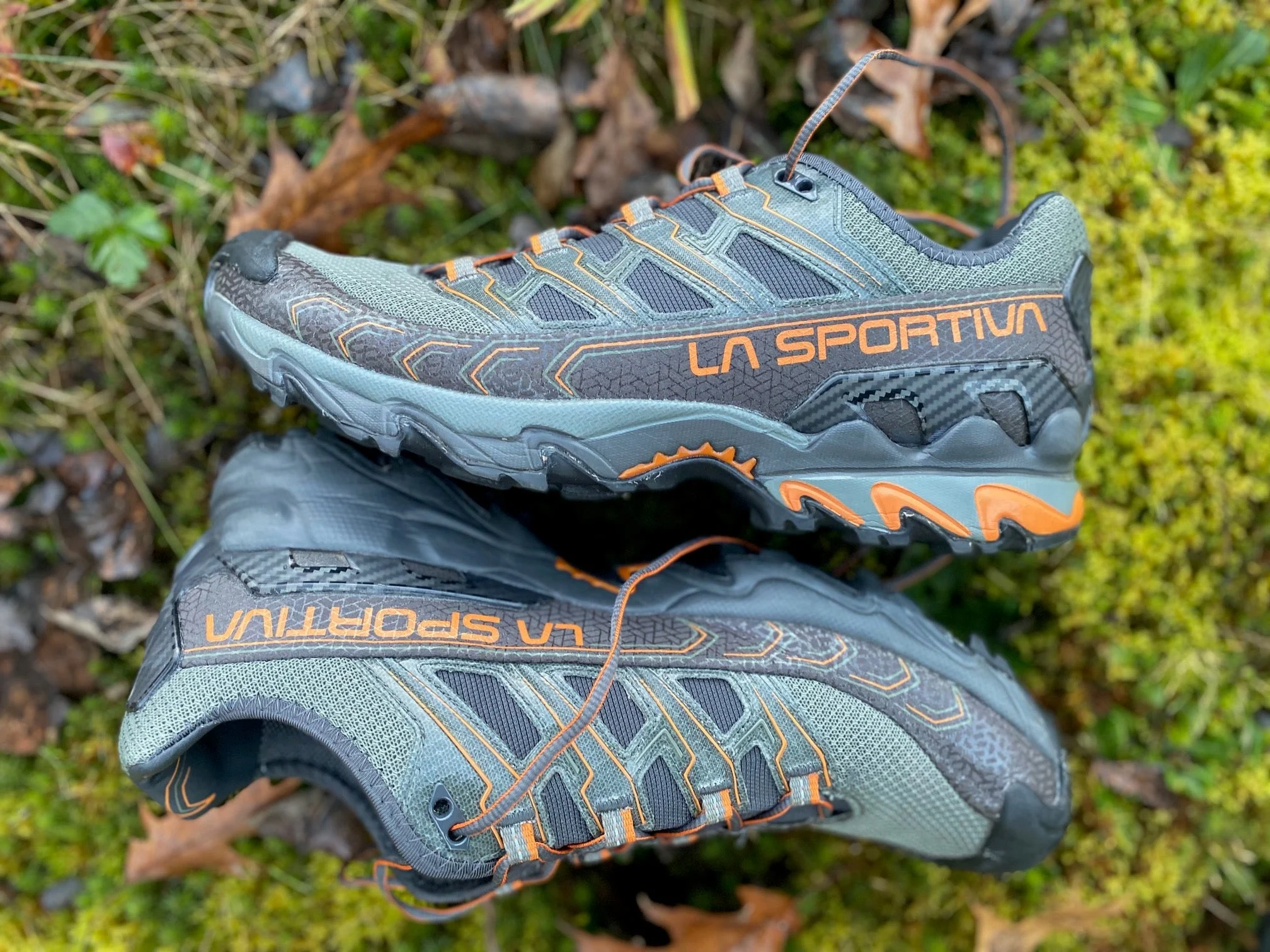
The Ultra Raptor II hiking shoes are supportive and come in three different color patterns. Lindsey Lapointe
Best Waterproof: Danner Trail 2650 GTX

Specs
Weight Per Pair: 1.7 pounds
Traction: Vibram 460
Waterproofing: Available in waterproof and non-waterproof models
Pros
Excellent waterproofing
Lightweight
Great look/stylish
Cons
Not for rugged trails
The Danner Trail 2650 GTX is arguably the best-looking shoe we tested. Our male tester found himself often wearing these to social events in addition to hiking. The body is made of a combination of full-grain leather along with a lightweight textile. The shoe is waterproof, yet very breathable thanks to the Gore-Tex liners. Our tester reported it needed no break-in period and was very comfortable right out of the box. The Trail 2650 is moderately stable though not a great choice for extreme terrain. We appreciated the protective toe cap, heel cap, and rock plate. The Vibram 460 tread is a nice choice for most moderate terrain. We found this shoe to have a medium-fit width and is available in wide as well. The Danner Trail 2650 hiking shoe turned out to be a fantastic choice for a transitional shoe that can cross from town to trail.
Best for Thru Hiking: Topo Traverse
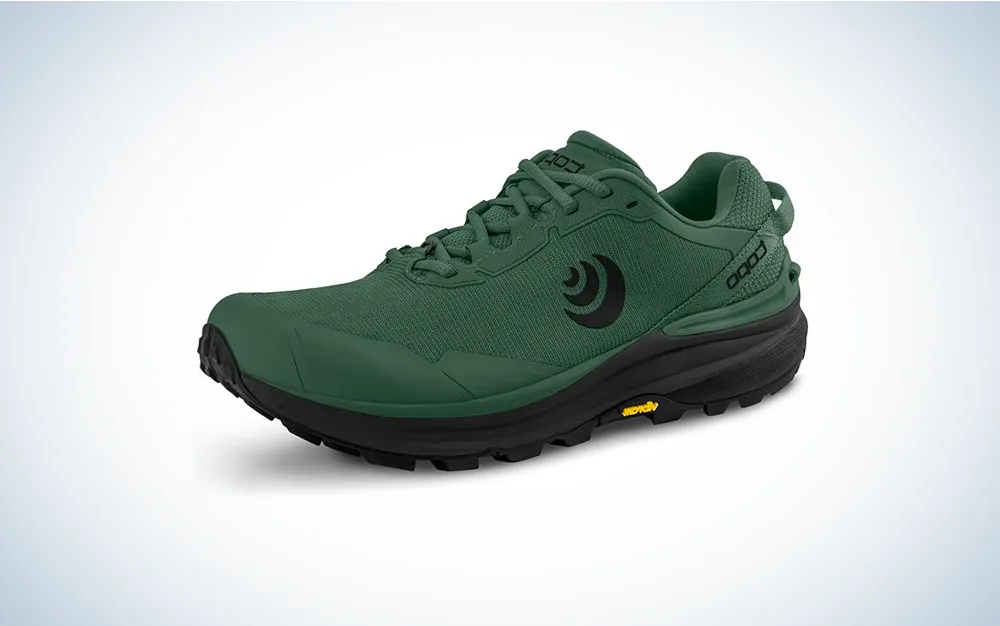
Specs
Weight Per Pair: 1.08 pounds
Traction: Vibram Megagrip with deep lugs
Waterproofing: Not waterproof
Pros
Ultralight
Quick draining
Comfortable fit
Cons
Only one color option
The Topo Traverse hiking shoe was specifically designed as a thru hiking shoe
. Since thru hikers put in long days and sometimes many months on a continuous hike, it’s extremely important to have reliable footwear. As a result, the Topo Traverse is packed with features to provide comfort, support, longevity, and traction. While these features might not be necessary for those simply walking local nature trails, this thoughtful design makes the Traverse a top pick.
The upper of the Traverse is a protective and tough mesh. It has the classic “Topo fit” that many long-distance hikers love, with a wide toe box for splaying toes along with a snug midsection and stiff heel. But there are a few features of the Traverse that really show why it’s a long-distance show. For starters, it has a quick dry design. From the drainage slits in the mesh to the non-absorbent insole, it caters to those who need their wet shoes to dry overnight. It also has a protective rock plate in the outsole, making for one of the most impressive outsoles in the entire testing group. I like the Vibram megagrip outsole for its well-spaced and deep lugs as well as sporting a softer rubber in the heel for traction on descents. While I wish it came in more colors than gray (or green for men), the Topo Traverse is one of the most thoughtfully designed hiking shoes I’ve ever seen and is a must-have for long-distance hikers.
Best Lightweight: Vasque Re: Connect Here Low

Specs
Weight Per Pair: 1.1 pound
Traction: X-shaped deep lugs
Waterproofing: Not waterproof
Pros
Ultralight
Comfortable midsole and heel rocker
Breathable and quick dry
Cons
Not for cold environments
The Vasque Re Connect Here is an ultralight versatile outdoor shoe. I like the overall look with the high stack midsole and rocker heel, which reminded me of the Hoka styling. However, unlike Hoka’s Speedgoats, this lightweight shoe has a stiff recycled mesh as the body. I found it provided exceptional breathability while still being supportive as well as protective. The padded heel-fit collar and wrap-around form-fitting tongue provided a snug, comfortable fit that made this a go-to shoe for everything from a trip to the grocery store to a hike on my local trail. The traction is impressive for a sneaker with a deep lug system through the outsole. However, the lack of lug variety makes me concerned it might not hold up on technical terrain. In addition, while it’s a perfect summer or desert hiking sneaker, the breathable mesh sides make it less than ideal for cold weather. Overall, the Vasque Re Connect Here is the perfect lightweight trail runner for the hiker looking for a versatile springy sneaker that can handle moderately tough terrain.
Best for Beginners: Oboz Sawtooth X Low
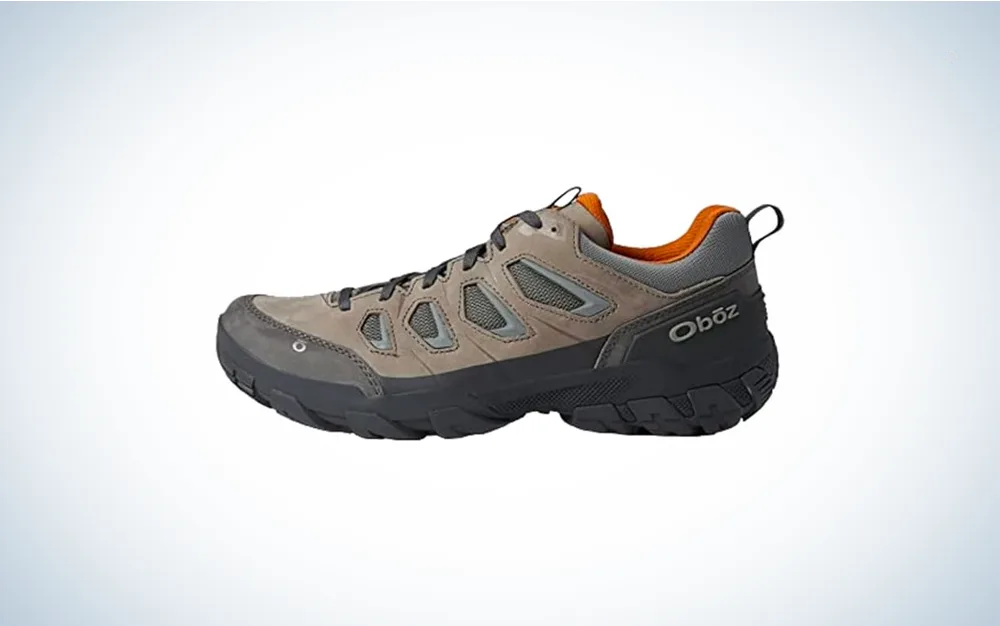
Specs
Weight Per Pair: 1.68 pounds
Traction: Variable deep lug design for all types of terrain
Waterproofing: Available in waterproof and non-waterproof
Pros
Arch support insoles
Durable and protective
Impressive traction
Cons
Bulky/heavy
This is the hiking shoe you want for a backpacking trip over rough terrain, a day hike in cool weather, or scrambling up sharp rocks. The Oboz Sawtooth X is a hiking shoe that provides comfort, yet protection for its hiker. To start with, these hiking shoes just have “the look” of a durable design. The Sawtooth X has a protective upper that provides a frame of nubuck leather with mesh breathing panels that protect the foot against sharp rocks, mud, and roots while having breathable openings. This, combined with the burly side lugs, is the perfect outsole to grip rocks and wedge into cracks.
The bottom lug pattern is versatile, perfect for anything from a mud-caked trail to a rocky ascent. Oboz has also put a lot of thought into comfort design. With the asymmetrical ankle collar for natural articulation to the O-fit insole with arch support, it’s hard to find any fault in the design. While some experienced hikers and thru-hikers will often steer away from traditional hiking shoes in favor of a lightweight trail runner, we feel the Sawtooth X is the perfect choice for a beginner hiker. This comfortable and protective shoe will keep your feet safe while you build skills in navigating tricky terrain.
Most Comfortable: Hoka Anacapa Low GTX
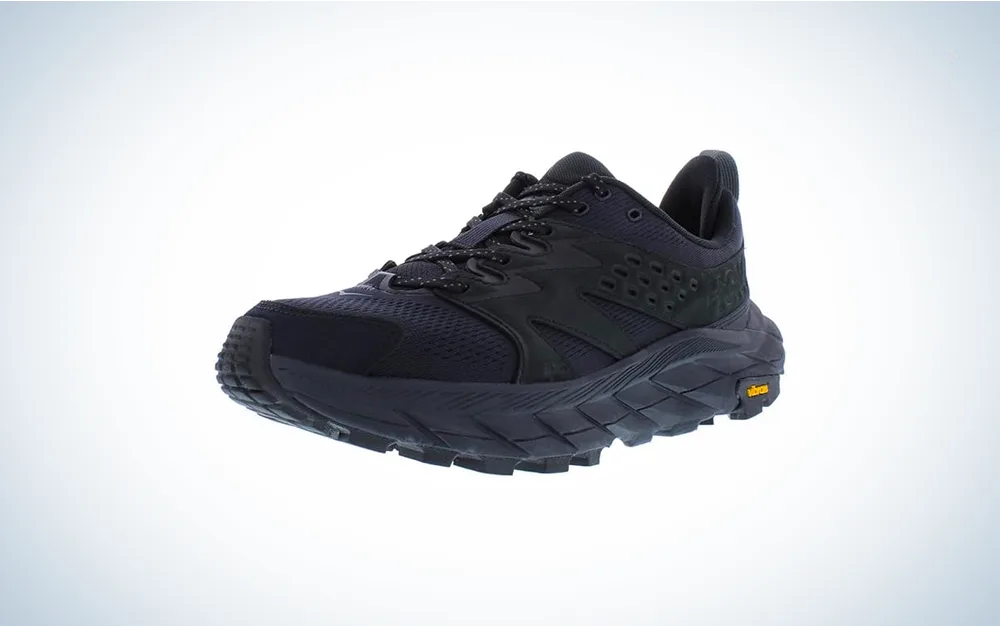
Specs
Weight Per Pair: 1.55 lbs
Traction: Vibram megagrip
Waterproofing: Available in waterproof and non-waterproof
Pros
Cushioned
Comfortable
Waterproof
Cons
Low ankle scoop brings in trail debris
The Hoka Anacapa Low GTX is a waterproof hiking shoe that’s so comfortable it’s easy to adopt as an everyday companion. The upper is made of mesh and nubuck leather with a waterproof Gore-Tex membrane. I found this shoe to be comfortable out of the box. The high stack midsole and rocker heel definitely put spring in your step and keep your feet comfortable over long days on the trail. I tested the GTX (waterproof) version on a particularly wet and challenging hike involving crossing large swaths of flooded trails, climbing volcanic rock slides covered in water, and across wet blueberry bogs. These shoes kept me dry. However, while the low dipping ankle provides great mobility, trail debris frequently entered my shoes over long sections of the hike. Purchasing the mid-rise version that has a higher ankle cuff might be a better choice for those traversing similar messy trails. While the shoe’s best feature is the comfortable midsole, the outsole is commendable as well. A Vibram megasole with varied 5 mm lugs is good on everything from mud and rock scree to slabby granite. All in all, the Hoka Anacapa is a great trail shoe for those prioritizing comfort.
Things to Consider Before Buying Hiking Shoes
Your hiking shoes are arguably one of the most important pieces of outdoor gear on the trail. Happy feet are the foundation of a comfortable stride. Here’s what to consider before buying hiking shoes:
Trail Type/Terrain
Consider the type of trail you’ll be traversing. If your preferred trails are packed dirt with gentle elevation changes with the occasional roots and rocks, then a rugged hiking shoe probably isn’t necessary. Trail running-type hiking shoes are a lightweight choice that still sports a decent tread. However, if you are continuously hiking on steep inclines, rocky and rooty terrain, and navigating over wet, icy, or slick trails, then opt for a more rugged hiking shoe. Leather bodies, rock plates, toe caps, and waterproofing protect the foot against harsh elements.
Fit
The best way to prevent hot spots and blisters is to ensure you have the right fit in your shoe. Since our feet stretch and swell as we hike, consider a hiking shoe with room. Features like wide-toe boxes are favored by hikers who want room for their toes to splay as they walk.
Waterproofing and Breathability
Many hiking shoes come with the option for waterproofing. This is a great choice for day hikers who frequently navigate wet or muddy trails. However, waterproofing often reduces the breathability and flexibility of the fabric. Therefore, summer or dry-climate hikers will prefer a breathable hiking shoe as their feet will be able to cool and sweat to wick.
Sole
Consider the amount of cushion you’d like in your next hiking shoe. Those with thick midsoles can be incredibly comfortable. However, this cushion often reduces the stability of the shoe as well as offers less flexibility against obstacles on the trail. Before purchasing, observe the outsole as well. Lugs and sole stickiness vary and match specific terrains.
FAQs
Q: Is it necessary to buy hiking shoes?
While it’s not absolutely necessary to buy hiking shoes, there are a few reasons why it is beneficial. For starters, hiking shoes are designed for trail use. As a result, the tread, support, and features cater to a rugged and variable environment. While sneakers can certainly be used to hike a trail, the typical hiking shoe will have a rock plate, toe cap, and tread to protect against rocks and roots. It might also offer a waterproof exterior to shield against rain and puddles. Lastly, while sneakers designed for asphalt and concrete generally have flat outsoles, a hiking outsole has lugs to grip onto rocks and release mud or snow stuck on the bottom.
Q: How do I stop my feet from hurting when hiking?
One of the best ways to stop your feet from hurting when hiking is to find the right shoe for you. If you are frequently getting blisters, it is likely that your shoe is too tight. When we hike, our feet expand, sweat, and rub. Try a half size up and look for a shoe like Keen, Topo, or Altra with a wide-toe bed. However, if the pain you’re referring to is due to bruising on the bottom of your foot, you might need more cushion to absorb the shock against your feet. Switch to a high-stack shoe like Hoka that will provide a thick layer of EVA foam to protect your feet against the impact of the ground.
Q: Is it better to hike in boots or shoes?
The decision to hike in boots or shoes is a personal one. But there are a few considerations for both. Hiking boots offer amazing support and stability. In addition, they protect more of the foot along the trail. However, they are heavy and can take some time to break in. I use hiking boots when backpacking, hiking on steep and/or rocky terrain, as well as hiking in colder seasons. Hiking shoes are lightweight and agile. They offer breathability and are versatile shoes to switch between town and trail.
Best Hiking Shoes: Final Thoughts
Best for Women: Keen NXIS Speed
Best for Men: La Sportiva Ultra Raptor II
Best Waterproof: Danner Trail 2650 GTX
Best for Thru Hiking: Topo Traverse
Best Lightweight: Vasque Re: Connect Here Low
Best for Beginners: Oboz Sawtooth X Low
Most Comfortable: Hoka Anacapa Low GTX
The hiking shoe is a versatile and lightweight option for everyone from casual day hikers to serious thru hikers. Before taking the plunge on a new pair, consider the support you desire, the climate and protection, and the special features needed to help make your shoes your favorite piece of hiking gear.
Why Trust Us
For more than 125 years, Field & Stream has been providing readers with honest and authentic coverage of outdoor gear. Our writers and editors eat, sleep, and breathe the outdoors, and that passion comes through in our product reviews. You can count on F&S to keep you up to date on the best new gear. And when we write about a product—whether it’s a bass lure or a backpack—we cover the good and the bad, so you know exactly what to expect before you decide to make a purchase.

